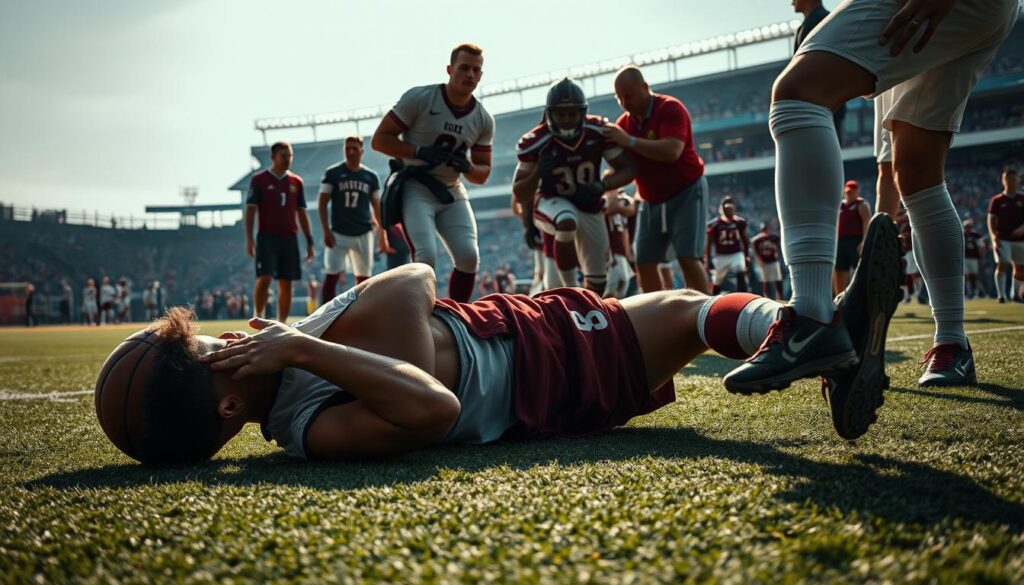Can virtual reality games help athletes recover faster from big sports injuries? The medical world is looking for new ways to improve rehab. Research shows that VR can change sports medicine a lot.
VR is now a key part of rehab tech. It lets athletes create their own recovery plans. This article explores how VR can change healing for sports injury victims. It looks at its new uses and its bright future.
Understanding Major Sports Injuries in Athletes
Major sports injuries often hit athletes in fast-paced sports like football and basketball. These injuries can cause big physical problems and hurt an athlete’s performance. Common injuries include muscle strains, ligament sprains, and concussions. ACL injuries are especially severe.
Injury stats show a worrying trend in sports. The UEFA Élite Club Injury Report found injuries during training happen about 2.8 times per 1000 hours. Athletes with serious injuries usually need around 20 days to recover. This shows how vulnerable athletes are and how tough rehab can be.
It’s scary to see that injured athletes are 4 to 7 times more likely to get hurt again. Knowing about major sports injuries and their stats is key to helping athletes recover better.

The Impact of Injuries on Athlete Performance
Injuries can greatly harm an athlete’s performance. They often lead to a loss of competition time and a drop in performance. This loss affects training, skill retention, and confidence.
The psychological effects of injuries are also significant. Athletes may face anxiety, fear of getting hurt again, and lower self-esteem. These feelings can make them hesitant or less aggressive in competitions, hurting their performance.
Long recovery times can create a cycle of poor performance. This not only affects individual athletes but also teams. It can lead to financial losses, lower morale, and a drop in team standings. Understanding the full impact of injuries is key to creating effective recovery plans for athletes.

Exploring Traditional Rehabilitation Techniques
Traditional rehabilitation is key in helping athletes recover from injuries. It uses physical therapy to get them back to their best. This includes exercises and manual therapy to improve strength and range of motion.
Cryotherapy and heat therapy are also used to manage pain and reduce swelling. These methods help athletes recover slowly and safely. Each athlete gets a plan that fits their injury, making recovery more effective.
But, keeping athletes motivated during recovery can be tough. It’s important to keep them engaged to get the best results. While these methods work well, they might not be as exciting as other recovery options.
Introduction to Virtual Reality in Rehabilitation
Virtual Reality (VR) is changing how athletes recover from injuries. It lets them practice in safe, controlled environments. This technology is making rehabilitation more effective, especially for sports injuries.
What is Virtual Reality (VR)?
Virtual Reality is an interactive experience that creates artificial environments. It allows users to dive into digital worlds. In sports therapy, VR offers customized exercises for different injuries and recovery levels.
This technology makes rehabilitation more engaging and effective. It helps athletes stay involved in their recovery journey.
The Evolution of VR Technology
VR started with simple gaming but has evolved significantly. Today, it includes advanced features like motion tracking and sensory feedback. This growth has made VR a valuable tool in healthcare.
Medical professionals use VR to create immersive experiences for better recovery. It offers a more effective approach than traditional methods.
VR in Recovery of Major Sports Injuries
Virtual reality (VR) is changing how athletes recover from big injuries. It brings new benefits to athletic rehab that old methods can’t match. VR creates real-life environments for exercises, helping athletes get back to their sport faster.
Studies show VR works well in rehab. Athletes feel more motivated and engaged with VR. This helps them regain motor skills and control, crucial for recovery. Plus, VR’s immersive nature helps athletes deal with pain by distracting them and encouraging movement.
VR lets therapists tailor rehab plans to each athlete’s needs. This flexibility allows for programs that adjust based on the athlete’s performance and feelings. It helps with both physical and mental recovery, helping athletes overcome injury challenges.
How VR Enhances Engagement and Motivation
Virtual reality changes how athletes recover by making it more fun and engaging. It uses gamification to turn boring recovery into an exciting game. This makes athletes more motivated to stick with their therapy.
Gamification of Recovery Processes
Rehabilitation can feel like a game with gamification. Athletes enjoy doing exercises that feel like challenges. They get to earn points and rewards, making them want to do more.
Immersing Athletes in Controlled Environments
Virtual reality puts athletes in safe, real-life-like settings. They practice skills in a way that feels like the game. This makes them more motivated and happy with their therapy.
Customizability of VR Rehabilitation Programs
Using customizable VR rehabilitation in athlete recovery plans is a big step forward. It lets us create plans that fit each athlete’s needs. This way, we can help them recover better by focusing on their specific injuries and recovery stages.
Tailoring Protocols to Individual Athlete Needs
Every athlete is different, and their recovery paths should reflect that. Customizable VR rehabilitation lets us create therapy plans that match each athlete’s unique needs. They can practice in virtual environments that mimic real challenges, helping them work on their strength and mobility.
This personalized approach makes athletes more committed to their recovery. It helps them feel like they’re getting a plan that’s just for them.
Data-Driven Approaches to Injury Management
Adding data-driven methods makes these programs even better. By looking at how athletes perform and respond in VR, we can tweak their plans on the fly. This feedback loop helps us make changes that speed up recovery and improve results.
Using this data, we can give athletes the best care possible. This means they can get back to competing sooner and stronger.
The Benefits of VR in Physical Rehabilitation
Virtual reality is changing physical rehabilitation, offering many benefits for athletes. It helps improve motor function and coordination. Athletes can practice specific movements in a controlled space, helping them recover faster.
Improving Motor Function and Coordination
Virtual reality greatly improves motor function. Athletes get exercises tailored to their needs. This leads to better coordination and muscle memory, key for top performance.
VR simulations mimic real sports, allowing safe practice. This helps athletes prepare for games without risk.
Effects on Pain Management and Recovery Time
VR’s immersive nature helps manage pain. Athletes feel less pain during rehab, thanks to the distraction. This reduces the need for drugs and shortens recovery time.
By controlling pain better, athletes can stick to their recovery plans. This boosts their chances of a quicker comeback.
Success Stories and Case Studies of VR in Sports Rehabilitation
VR success stories show how sports teams use new tech to help athletes recover faster. These stories highlight big improvements in recovery and more athlete involvement in rehab.
Highlighted Outcomes from Professional Sports Teams
Recent studies show teams like the Los Angeles Rams and Cleveland Cavaliers using VR for rehab. They’ve seen athletes recover quicker and stick to their therapy plans better. This shows VR can help athletes get back to sports faster and perform well.
Analysis of Patient Engagement in Real-World Settings
Studies on VR in rehab show athletes are more motivated and happy with their treatment. The immersive VR experience makes them more committed to rehab. This leads to better mental health and recovery, proving VR is a key tool in sports rehab.
Challenges and Limitations of VR Rehabilitation
VR rehabilitation offers new ways to help people recover. But, it also has big challenges. Knowing the technical limits is key for using it in hospitals.
VR tech is expensive, which stops many places from buying it. Also, training staff to use VR takes time and effort. This makes it hard to start using VR right away.
Technical Barriers and Costs
VR faces technical hurdles. Buying VR headsets and tools is very costly for many rehab centers. Keeping the equipment updated also costs a lot.
This makes it hard for patients who could really benefit from VR to get it.
Addressing Cybersickness and User Comfort
Comfort issues are a big problem with VR. Cybersickness, like feeling sick or dizzy in VR, is a big challenge. It’s important to make VR fun but also comfortable for users.
Developers and doctors need to find ways to reduce these problems. This will help make VR therapy more effective.
The Future of VR in Sports Injury Recovery
Virtual reality in rehabilitation is growing fast. New tech keeps coming, making VR in rehab look bright. Soon, VR might use artificial intelligence for custom plans, fitting each athlete’s needs.
These new tools could make recovery faster and more fun. It’s all about making therapy more personal and effective.
Advancements in VR Technology
New VR tech is changing sports medicine. It includes real-time feedback and challenges that change as you progress. This makes recovery feel like a game, not just therapy.
It lets athletes take part in their healing. This could lead to better results, as they’re more involved in their recovery.
Potential for Wider Adoption in Clinical Settings
VR is becoming more accepted in hospitals. More studies show VR helps in rehab, so doctors are starting to use it. Adding VR to treatment plans could change how we heal athletes.
It could make recovery better for everyone. VR could become a key part of helping athletes get back in the game.
Conclusion
VR technology is changing how we treat sports injuries. It makes recovery more engaging and effective. This new approach focuses on each athlete’s needs, making treatment more personalized.
VR’s role in sports medicine is growing. It helps athletes recover faster and manage pain better. This shows VR is more than a trend; it’s a real solution for better recovery.
Research on VR in sports medicine is promising. It’s making VR more accepted in the field. As we learn more, VR will become a key part of treating sports injuries. This will help athletes get back to their games faster and stronger.





